50 years ago this week, on September 19, 1970, Mary Richards moved into 119 North Weatherly in Minneapolis, Minnesota. Escorted by building manager and friend, Phyllis Lindstrom and her daughter Bess, Mary steps into the space and marvels at what she sees. It’s perfect! A stylish, one-room apartment. There’s only one little problem…and it’s right outside the window. As Phyllis opens the curtains to show Mary the balcony and view, the “problem” is there washing the windows…Rhoda.
You have just stepped back in time to greet three of the main characters on The Mary Tyler Moore Show, a trio of friends – and enemies – who have filled homes with laughter for five decades. Thanks to the pleasures and convenience of streaming, you can still catch episodes of this situation comedy every day. And I urge you to. Not because of the show’s 67 Emmy nominations or 29 wins, or an ensemble like few others, or its extraordinary writing, but because you will laugh and fall in love. Repeatedly.

After doing George Roy Hill’s Thoroughly Modern Millie (1967) and a stint on Broadway, Mary Tyler Moore co-starred in a TV special with Dick Van Dyke, Dick Van Dyke and the Other Woman, which was hugely successful. Taking notice, CBS asked Moore if she was interested in starring in her own sitcom. Moore’s husband at the time, producer Grant Tinker, suggested they create a company, which they called MTM and ascribed to it an orange kitten as a logo animal that fans of the show got used to seeing every week. The kitten idea came from the fact that MTM is similar to MGM, which used a lion as its logo animal.
The original premise for The Mary Tyler Moore Show had the show’s main character working at a small television station as a divorced woman who just moved to Minneapolis. CBS heard the idea and blew its top; everyone would think Mary Richards got divorced from Dick Van Dyke, which would turn audiences off immediately. Moore had made a splash on The Dick Van Dyke Show as Laura Petrie, her appeal and natural talent for comedy readily apparent to all. Created by Carl Reiner, the Van Dyke show ran from 1961 to 1966 and audiences loved Dick Van Dyke and Mary Tyler Moore as a couple.
Except for the divorced woman angle, the idea of creators James Brooks and Allan Burns came to fruition. Mary Richards, a single woman in her thirties, was different from most single women depicted on TV at the time. She was not widowed or divorced or seeking a man to support her. When the show started, Mary just broke off a long relationship with a man she lived with determined to make it on her own in Minneapolis. Mary found a job in the newsroom of WJM, the lowest rated station in its market, but her relationships at the station and those with her neighbors form familial bonds that warm the heart and make one roar with laughter. In fact, The Mary Tyler Moore Show’s success relied primarily on its characters and we could not get enough of the lot of them.
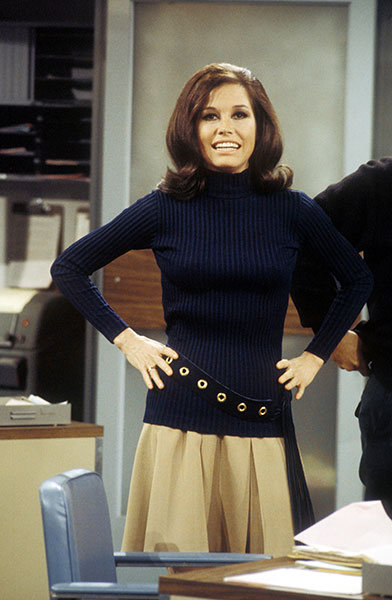
I was surprised to learn that Mary Tyler Moore’s favorite episode from the series is also mine centering on Mary Richards. It is, “Put on a Happy Face” from the series’ third season. It’s the week of the Teddy Awards and Mary Richards is having a terrible time. A bunch of mishaps plagues Mary and threatens to make her a miserable person. She spills coffee on a new sweater, she finds out she made a big mistake at work, her awards dinner date cancels on her, she has an ugly hair bump embarrassing enough to be noticed by Ted Baxter, she sprains her foot and gets a cold. It is just one of those weeks and our Mary just does not have those types of weeks. Alas, the night of the awards arrives and Mary, stuck going with Ted Baxter as her date, looks like a complete mess. She is wearing a dress borrowed from Rhoda and her hairdryer broke so her hair is in shambles. The night does not get any better. As Mary is announced as the winner of the Teddy for producing “The Sunday Show”, she is fixing her false eyelash, which fell unto her cheek moments earlier. Her acceptance speech is pure Mary, a weepy “I usually look so much better than this.”
Mary Richards is perfect in every way, which is why that episode is so funny. Well wait, except when it comes to hosting dinner parties, which are usually terrible. Veal Prince Orloff anyone? Ms. Richards is a woman of substance who stands up for what she believes. When she finds out that the man who had her job before her was paid more, she does not hesitate to take it to her boss demanding more money. Well, demanding in that soft-spoken, shy, Mary Richards sort of way. Mary could also always be counted on, she is a good friend who always does the right thing and sees the best in other people. To illustrate that consider the insufferable, self-absorbed Phyllis Lindstrom is one of her best friends.
As the lead in an extraordinary ensemble cast, Mary Tyler Moore cannot be beat either. Moore often lets the other cast members get the biggest laugh and as a result I’d venture to say that Mary turns out to be one of – if not the – greatest straight person in the history of situation comedies. Not to mention that Moore is credited with incarnatng the modern woman on Television. (NYT)
Speaking of Phyllis Lindstrom…
The brilliant Cloris Leachman plays snobbish, meddling, egotistical, shallow Phyllis Lindstrom. Phyllis is a good friend to Mary, a friend who always has advice to offer whether or not she is asked. We later learn that Phyllis and her dermatologist husband Lars are the property owners of the building where Mary and Rhoda live in, which lends itself to interesting exhcnages. I will keep saying throughout this post that this one or the other one are simply stupendous as whomever they are playing on this show. It is no exaggeration. I dare you to find anyone – anyone – in sitcom history who can deliver a line like Cloris Leachman. If you want to visit a great episode centered on her, try Phyllis Whips Inflation from season five. Her husband Lars puts her on a budget and Phyllis just will not have it. Phyllis’ flare for dramatics is in full bloom in this one and it is fantastic.
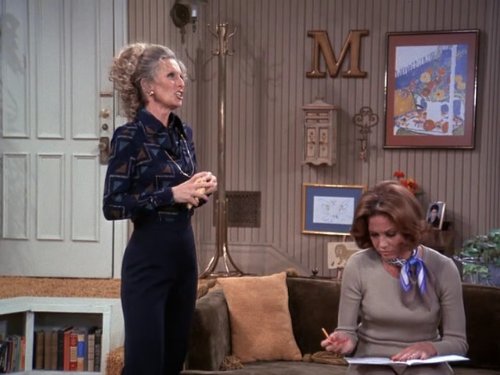
If you want testament to the acting powers of Cloris Leachman, there is a scene in season three episode, It Was Fascination, I know, you should watch again. Phyllis breaks your heart – and that of Mary and even Rhoda – as she recounts not having had a date for prom night. She recalls how she pretended by putting on her dress and going to the movies, staying for three screenings so that everyone in her family would think she went to prom. You can hear a pin drop as she remembers how she cried herself to sleep that night. Staring at the ground, clearly reliving the sadness, she has us all in the palm of her hand. Then suddenly the Phyllis we know is back as she jumps up off the couch, “Well! Sure was fun talking about it.”
What about Phyllis’ eternal war with nemesis Rhoda? There is a bit of jealousy there, Phyllis wondering how in hell a classy woman like Mary can be friends with a dame like Rhoda.
Phyllis: [Mary’s talking to Rhoda, who’s about to leave her apartment. As Rhoda opens the door, Phyllis walks in – looks at Rhoda, then goes straight to Mary] “Yoo-hoo, Mary, I’m glad I caught you alone. Are you busy?”
Rhoda serves it back at every opportunity…
Phyllis: [to Mary and Rhoda] “I thought I’d see how you swingin’ singles spend your evenings!
Rhoda: “They’re not much different than yours. We sit around at night wondering what it’d be like to have a happy marriage.”
In 1975, Cloris Leachman left The Mary Tyler Moore Show to star in spin-off series Phyllis. In the spin-off Phyllis and daughter Bess (Lisa Gerritsen), who does a terrific job on The Mary Tyler Moore Show, relocate to Phyllis’s hometown San Francisco after the death of Lars.
Rhoda Morgenstern was penned as abrasive, hard-edged, and frumpy, but she also had to be loveable. Not an easy character to play. Yet we know that Valerie Harper hit it out of the park with her portrayal. I already dedicated an entire post to Rhoda and Ms. Harper, which you can read here, so I will not go into favorite scenes, but a bit about how she got the part,\ is always interesting.
“If nothing else, food will always love you back.”
Then casting director for CBS, Ethel Winant, who later became the first woman executive in television when she became the vice-president of CBS, saw Valerie in a play. Winant called Valerie in to audition, the most important audition of her life as Valerie Harper later referred to it. She did the opening scene, the one described at the opening of this post where Rhoda is cleaning the windows to her apartment. Valerie was called in a second time to read with Mary Tyler Moore and before she got home from that session the part of Rhoda was hers. Ms. Harper created a character that many identified with. Rhoda is flawed, she is blunt and funny and can be abrasive, but she also does not win at life things like Mary does. Rhoda is cynical and lovable, someone we want to help. She is self-deprecating and hilarious and we identify and care for her. Rhoda became half of a legendary friendship that many young women wanted to emulate; she was the trendy to Mary’s classic. A perfect combination.

Like Cloris Leachman, Valerie Harper left The Mary Tyler Moore Show for her own spin-off in 1974. After that, the Moore show shifted from primary stories set in Mary’s apartment to the center being the WJM newsroom. Ed Asner commented that that is when the guys got the opportunity to strut their stuff. Although everyone missed their beloved Rhoda, the cast of this show is so rich with talent that the quality remained as good – or got better.
Ted Baxter was supposed to be tall, dark and handsome, a love interest for Mary Richards. As Moore describes it, however, “then they saw Ted Knight with all his bluster and they decided to leap at the opportunity that Ted offered them.” Ted Knight as Ted Baxter is beyond brilliant, for my money the funniest character on TV. Ever. Of Knight Time magazine wrote, “Knight embodied a wonderful comic oaf: vain, inept and hilarious.” Ed Asner recalled that he and Gavin MacLeod hated him (in jest) because Knight was so brilliant at comedy he could play each laugh several different ways and be as funny each time.
Ted: [on air] I’ve just been handed a bulletin. [reading in announcer’s voice] You’ve got something between your teeth.”

A few of my favorite Ted Baxter moments and there are many: season 5 episode You Can’t Lose ‘Em All, which is replete with Baxter gems. It is Teddy Awards time again and Ted came in early to write letter to the television editors to try to influence their votes. When Mary reads one of Ted’s letters I die laughing, “Dear Ed, I know you’re not supposed to criticize a critic, but I can no longer refrain from telling you that I consider you the most brilliant reviewer in the Western hemisphere. Your review of Tony Orlando and Dawn will live in literature.” Lo and behold, despite those efforts and Ted’s spending the week visiting the sick in hospitals, he does not even get a Teddy nomination and Lou Grant has to tell him before he reads it in the paper. What ensues is the funniest scene I have ever seen on a situation comedy. With bottle of scotch in front of him for courage, Grant squirms in his seat unable to break the news to Ted. As time passes without Lou saying a word, Ted starts getting nervous realizing it may be bad news until he is in a crying frenzy, breaking down completely when he learns he was not even nominated for the Teddy. I go into fits of laughter whenever I watch this scene; the way it builds to its conclusion is nothing short of genius. When Ted composes himself and comes out of Lou’s office, he tells Mary and Murray he knows exactly how he will get back at the world…he will let his appearance go to hell. By the way, the episode’s title actually references the awards and Lou Grant who wins a lifetime achievement tribute usually given to people who have one foot in the grave.

Another standout episode for Ted Baxter for me is the one where we find out Murray has a gambling problem from season three, It’s Whether You Win or Lose. Ted takes advantage of Murray’s issue by betting that he (Ted) will not mispronounce the name of a Japanese leader. It is impossible not to laugh in the end when he botches the name and Murray has learned his lesson. Look at my post dedicated to that one here.
Gavin MacLeod originally read for the Lou Grant role, but told the powers that be that he was all wrong for that role. Instead, MacLeod asked to read for Murray who was intended as a nemesis for Mary Richards. Gavin MacLeod walked in, however, and his warmth permeated the room causing the writers to reverse course. A warm and fuzzy Murray was better to write for. I met Mr. MacLeod at a Chiller Theater expo two years ago, by the way, and he is as warm and loving to fans too. While others waited to get his autograph, he sat me down, talked about his good friend Ted Knight and about Betty White, who he had recently spoken to. I was in heaven. Anyway, Murray and Mary become best friends at work. Actually, today they would be referred to as each other’s work spouses. They are adorable together, completely loyal and sweet and when anybody disrespects Mary, if that were ever to happen, Murray would be all over them. However, Murray’s greatest gift is as spoiler to Ted’s erroneously inflated ego. Murray’s zingers are legendary and they are a perfect fit for his cynicism.
Ted: [bragging] I even got cheered for cutting a ribbon at a supermarket!
Murray: That’s because they didn’t think you could do it.”

Every comedy show needs a cantankerous character, the one who is always angry and uncooperative and The Mary Tyler Moore Show has Lou Grant. Played by Ed Asner the Lou Grant character suffers the same fate as the others on this show. That is, he is complex, fully rounded, and although angry he evolves to lovable. No one knew Asner could play comedy. As he recalls, he was working on 1971 TV movie, Walter Grauman’s They Call It Murder, a mystery based on the characters of the Erle Stanley Gardner in which Asner plays a police chief. Although Asner infused humor into the police character, he said he avoided comedy as a rule. He just thought he did not know how to do it. Well, Grant Tinker saw the dailies for They Call It Murder and asked one of the CBS executives if Ed Asner could do comedy. She replied, “Ed Asner could do anything.” That person was right.
“If I don’t like you, I’ll fire you! If you don’t like me, I’ll fire you!”
The ultimate gift of The Mary Tyler Moore Show, aside from the laughs, are the relationships between the characters and how much we get to know them. Lou Grant is a perfect example. During the life of the series, we live through Lou’s troubles in his marriage, the separation and eventual divorce. Priscilla Morrill plays Lou’s wife Edie and together with Asner, she created many touching moments on the show.
Ed Asner went on to star in a spin-off called Lou Grant after the Moore show. This was unique in that it was the same character continuing a linear story in his life as an editor in a drama, instead of going off into another situation comedy.
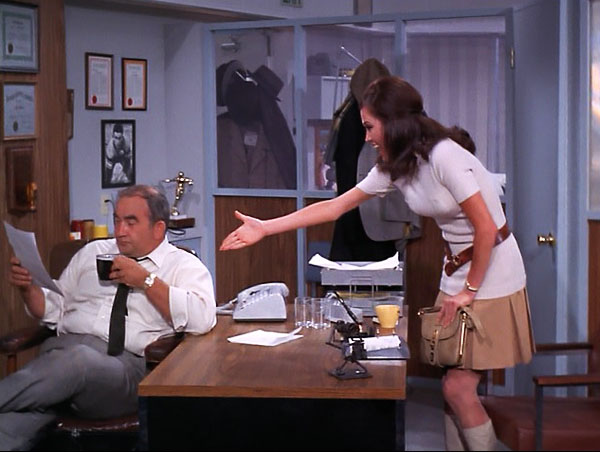
Introduced in 1973, upon Valerie Harper’s exit, is the character of Sue Ann Nivens played by the incomparable Betty White. Ms. Nivens makes her debut in an episode entitled “The Lars Affair” during which we see her for the first time as “The Happy Homemaker” , a daytime show host who gives cooking and decorating advice to housewives. What she also does to housewives is cheat on their husbands as she does in this episode with Phyllis’ own Lars. White sets the stage perfectly for all of the memorable moments we’d see for the next four years. While everyone surely missed Mary’s best friend, Sue Ann is a hilarious, sharp-tongued, sex-starved breath of fresh air. I am not sure I can put into words how much I adore Betty’s turn as Nivens. All I can say is that it takes a unique talent to join the likes of the Moore show with its superbly talented cast and writing and make it even funnier.
The role of Sue Ann Nivens was not written for Betty White, but the script for “The Lars Affair” called for a woman “as sweet as Betty White, but as vicious as a barracuda” according to Mary Tyler Moore. There were trepidations about approaching Betty White, however. As it turns out, White and husband Allen Ludden were good friends with Mary Tyler Moore and Grant Tinker. Moore explained that producers, aware of Moore and White’s friendship, were hesitant to audition Betty Whitefearing that if she were not right, it would create awkwardness between the two couples. Luckily, none of that happened and with a week’s advance notice Betty White became Sue Ann Nivens for what was supposed to be one episode. As Mary Tyler Moore described her, “She was so good, so inventive that we couldn’t not have her back.” Series creator, James L. Brooks called White after the first episode and said, “Don’t make too many plans.”
There are far too many great Sue Ann moments to mention, but one can never forget when we get to see inside her bedroom for the first time in season seven episode, Sue Ann’s Sister. Younger sister Lila comes to town. Already a rival, Lila not only hits it off with Lou Grant, whom Sue Ann has always had the hots for, but Lila is offered the chance to host her own show almost exactly like Sue Ann’s. Naturally Sue Ann goes into a deep depression prompting Mary to have the WJM group to cheer her up. That’s when we see her lavish, mantrap of a bedroom.
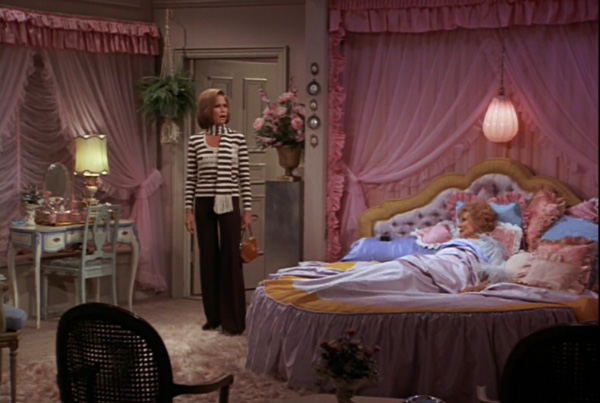
Another memorable episode is A New Sue Ann from season five. Here Sue Ann makes the sister of an old friend of Mary’s her stand-in. Before you know it the young woman, Gloria Munson (Linda Kelsey) is getting all the attention and Sue Ann Nivens is having none of it. While we get a glimpse of Sue Ann’s vicousness throughout her time on the show, we really see the extent to which she will mess somebody up if he or she gets in her way. It’s as though she’s a society lady – albeit a slutty one – with a nasty boxer near the surface. All done in riotous humor, Betty White’s Sue Ann Nivens nearly steals every scene.
I would be remiss not to mention a few of the other terrific recurring characters who helped make The Mary Tyler Moore Show a joy to watch. Georgia Engel plays Georgette Franklin, brought in as a love interest for Ted Baxter in 1972; she stayed until the end with her lovely portrayal of the sweet-talking, air-heady love of the ancherman’s life. She’s the only one who could possibly put up with him. Theater and game show veteran Joyce Bulifant plays Murray’s wife Marie. Gordon Howard, or Gordy as we all know him, the WJM weatherman, is played by John Amos who left the show to do Good Times. My favorite thing about Gordy is how obvious he makes it seem that he is far too good for WJM. The great Eileen Heckert plays Mary’s Aunt Flo although she was actually a distant cousin. Flo is a brilliant, award-winning journalist who speaks her mind. Finally, we have the parents of Mary and Rhoda all played by veteran comedy actors. Harold Gould and Nancy Walker play Martin and Ida Morgenstern. Bill Quinn and Nanette Fabray play Walter and Dottie Richards. To say that inspired casting went into those choices would be an understatement.
The premise of the final episode of The Mary Tyler Moore Show is superb. A new owner buys WJM and fires everybody. Except Ted Baxter. Everyone prepares to leave forever, each other and us. Then there is a group hug for the ages, mostly unscripted by a group that one can tell truly love each other. Mary Tyler Moore said that she was one of the lucky few because she knew she served some people very well. I hope she meant millions of some people because I cannot imagine my world without her show. When Lou Grant tearfully exclaims in that episode, “I treasure you people” at the end, he speaks for all of us.
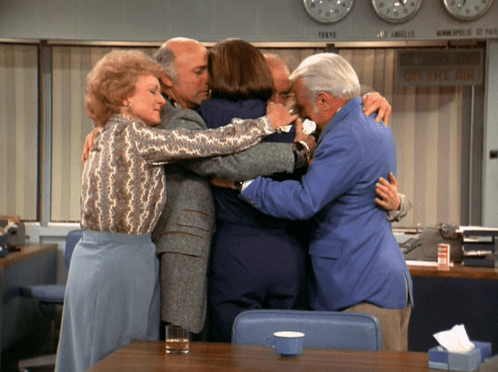
Perhaps the most iconic image of The Mary Tyler Moore Show was during the show’s opening sequence when Mary throws her hat up in the air. That image became a symbol of the show, of the woman, of all women in some sense. Moore explained it happened quite by accident. They were taking shots of her in action to use as needed. She was in front of a department store when she was told to run out into the intersection and toss her hat up in the air as if it were the happiest moment of her life. She did. I cannot watch that short piece of the video without smiling as memories of the wonderful show and the talented people in it flood my mind. I tip my hat to The Mary Tyler Moore Show for all the feels through the years. I know I’m just one of millions who love this show, but it feels personal. Like love truly is all around. That’s how good these people are in this show.

I have visited with the gang at WJM countless times through the years and now the show is a go-to during the age of COVID. I recommend this series to anyone looking for a distraction, or to be inspired by greatness, but I especially do during these trying times.
Working in Mpls I walked past her hat throwing statue for years. A co-worker lived in the house that Mary ‘lived’ in. Many a night he was wakened by people yelling for Mary.
It was and still is an all time great TV show. The scripts! The characters! The actors!
And of course the oh so talented show business genius. Gosh. She sure was SPUNKY.
She sure is!! I gotta go see that one day.
When Janet was in high school a friend loaned me the DVD set of the series and it was such a joy to share those people with my daughter. She immediately fell for the show. It is a cherished memory and we often quote lines to each other. She has in her possession (from me) her own DVD set of the series and a WJM coffee mug.
Once, pondering a question posed online I muttered “funniest sitcom character.” Entering the room at that moment, Janet didn’t hesitate to say, exasperated that I was having trouble, “Ted Baxter.”
I’ll be sending her a link to this article. I don’t know if she will laugh or cry; probably both.
Oh, Paddy. That makes my heart all warm and fuzzy. Thank you. I love those memories. And yes, Ted Baxter without a doubt. He really does make me ugly laugh.
It was a lovely show. I haven’t seen it in years. Thanks so much for the wonderful write up, Aurora!
Hey Caren! Hope all is well. Thanks for stopping in. Take a look at it again. It lifts moods on any day.
One of my fondest early memories is my parents tuning in weekly for the MTM-Bob Newhart Show lineup. They loved those shows then, and even though I wouldn’t really appreciate the humor until I watched both of them again years later, it’s nice to look back and think about that. Here’s to Mary!
Indeed!! That was some fantastic Saturday night line-up!
I recently discovered this extraordinary show and immediately fell in love with it, As you’ve said, repeatedly! Clean jokes and yes, truly creative writing and close to humanity. ALL of them gave their best, that’s why its such a classic act. Come to think about the fact that I was not even born when the show concluded and yet I’m so in love with it, this show definitely has its charm. Loved to bits the way you wrote this. Thank you!
Thank you so much for the comments. I’m thrilled you discovered this gem.